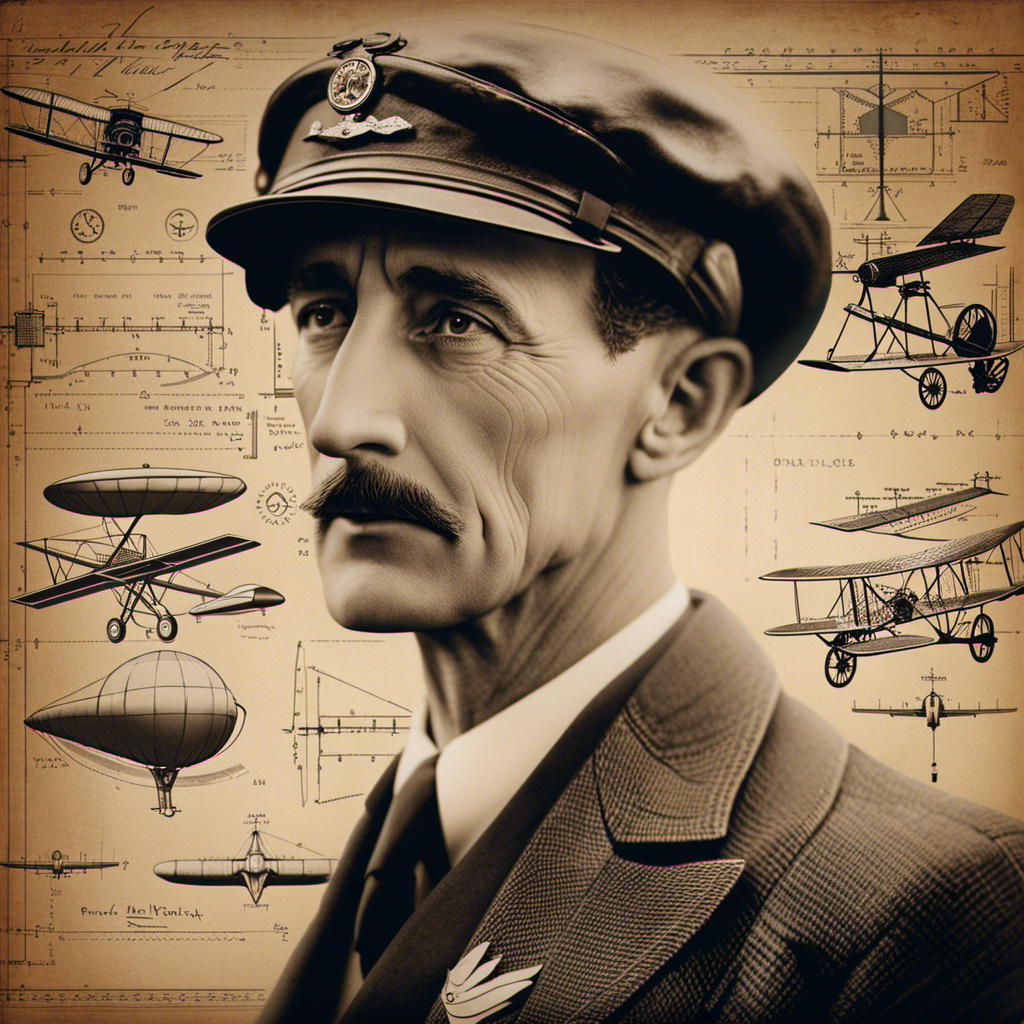Get ready to embark on an extraordinary journey of discovery about the incredible life and achievements of Wilbur Wright! In this article, you’ll delve into the captivating world of aviation as you uncover fascinating fun facts about one of history’s most influential figures.
From his early experiments with flight to the groundbreaking Kitty Hawk flight, Wilbur’s innovative spirit and unwavering determination will inspire you.
So join us now and become part of a community that celebrates the remarkable legacy of Wilbur Wright.
Key Takeaways
- Wilbur Wright was born on April 16, 1867, in Millville, Indiana.
- His strong educational background developed critical thinking skills for his aviation experiments.
- The Wright Brothers’ early attempts at flight transformed our perception of what is possible.
- The Wright Brothers’ flight experiments revolutionized aviation.
Early Life and Education
You’ll be interested to know that Wilbur Wright’s early life and education greatly shaped his future as an aviation pioneer.
Born on April 16, 1867, in Millville, Indiana, Wilbur grew up in a family that valued education. His parents encouraged his curiosity and provided him with books and tools to explore the world around him. As a child, Wilbur enjoyed spending time outdoors, observing birds in flight and building kites. These childhood hobbies sparked his interest in aviation and laid the foundation for his future experiments with flight.
With a strong educational background, including attending high school and completing three years of college at various institutions, Wilbur developed critical thinking skills that would prove invaluable when he and his brother Orville embarked on their journey to conquer the skies.
First Experiments With Flight
Imagine a world where the sky is no longer out of reach, where humans soar through the air like birds, defying gravity with their own ingenuity.
The Wright Brothers’ early attempts at flight were the catalyst for this magnificent transformation, forever altering our perception of what is possible.
Through their tireless experimentation and unwavering determination, they not only achieved the dream of flight but also paved the way for countless advancements in aviation that have shaped our modern world.
Wright Brothers’ Early Attempts
When it came to the Wright Brothers’ early attempts at flight, you’d be surprised by their persistence and determination. Despite facing countless early failures and challenges, they never gave up on their dream of achieving human flight. Their unwavering belief in themselves and their innovative approach set them apart from others. In a world where success seemed impossible, they pushed boundaries and defied expectations.
| Early Failures | Challenges Faced |
|---|---|
| Unstable aircraft designs | Lack of funding |
| Inadequate engine power | Limited knowledge of aerodynamics |
| Difficulty controlling the aircraft’s pitch | Skepticism from the public and media |
They embraced these obstacles as opportunities for growth and learning. Instead of being discouraged by their setbacks, they used them as stepping stones towards progress. Through trial and error, they made incremental improvements to their aircraft, constantly refining their designs based on what they learned from each failure.
Their journey was not an easy one, but their determination ultimately led to one of humanity’s greatest achievements – powered flight. The Wright Brothers’ story inspires us all to persevere in the face of adversity and reminds us that with enough passion and resilience, anything is possible.
Impact of Flight Experiments
The impact of the Wright Brothers’ flight experiments can still be felt today. Their determination and ingenuity revolutionized the world of aviation, leaving an indelible mark on technology and inspiring generations of future aviators.
Their groundbreaking achievements paved the way for countless advancements in aircraft design, propulsion systems, and aerodynamics. Through their relentless pursuit of flight, they opened up new possibilities for exploration, travel, and global connectivity.
Their influence on technology cannot be overstated. The principles they discovered and refined during their experiments laid the foundation for modern aviation as we know it. From the development of more efficient engines to the creation of safer and more reliable aircraft, their work continues to shape the industry.
But perhaps their greatest legacy lies in their influence on future aviators. By proving that human flight was possible, they sparked a sense of wonder and possibility in aspiring pilots around the world. They inspired dreamers to pursue careers in aviation and pushed boundaries further than ever before.
Today’s aviators owe a debt of gratitude to these pioneering brothers who dared to chase their dreams against all odds. The impact they had on technology and the influence they exerted over future generations is immeasurable. As we soar through the skies in modern airplanes, let us remember those bold visionaries who made it all possible – Orville and Wilbur Wright.
The Wright Brothers’ Invention
Imagine a world where the sky is no longer a boundary, but a limitless playground for exploration and discovery.
In this new era of aviation, the Wright Brothers’ invention has revolutionized the way we travel through air. Their innovative flying machine design has paved the way for future advancements in aviation, pushing technological boundaries and redefining what was once thought impossible.
The impact of their creation on aviation cannot be underestimated; it has opened up endless possibilities and inspired a generation of dreamers to reach for the skies.
Flying Machine Design
To understand how the Wright brothers revolutionized flying machine design, you should take a closer look at their innovative ideas and engineering techniques. Their understanding of the aerodynamics of flight allowed them to create aircraft that could stay in the air for longer periods of time and maneuver more efficiently. They introduced several groundbreaking concepts that shaped the future of aviation.
Here is a table showcasing some of their key contributions:
| Contribution | Description | Impact |
|---|---|---|
| Wing shape | Developed curved wings to generate lift and reduce drag | Improved overall efficiency |
| Three-axis control | Utilized separate control surfaces for pitch, roll, and yaw | Provided better stability and control |
| Propeller design | Designed efficient propellers for propulsion | Increased speed and performance |
The Wright brothers’ pioneering work laid the foundation for modern aircraft design. By pushing boundaries and challenging existing norms, they paved the way for humanity’s journey into the skies.
Impact on Aviation
Take a moment to consider how the Wright brothers’ contributions to aviation have shaped the way we fly today. Their inventions and technological advancements have revolutionized the field of aviation, paving the way for modern air travel.
Here are three ways in which their innovations continue to impact our lives:
- The Wright brothers’ development of the first successful powered aircraft opened up new possibilities for transportation, allowing people to travel long distances in a fraction of the time it would take by other means.
- Their invention of flight controls, such as wing warping and three-axis control, laid the foundation for future aircraft designs and influenced how pilots navigate and maneuver planes even today.
- The Wright brothers’ commitment to innovation inspired countless others to explore the possibilities of flight, leading to further advancements in aviation technology that continue to shape our world.
Thanks to their pioneering spirit and ingenuity, we now enjoy safer and more efficient air travel that connects us with people around the globe.
The Kitty Hawk Flight
The Kitty Hawk flight was a groundbreaking achievement in aviation history. Imagine yourself witnessing that momentous day when the Wright brothers’ success took flight.
It was December 17, 1903, and as you stood on the sandy shores of North Carolina, you couldn’t help but feel a sense of awe and wonder. The Wright brothers had defied gravity and soared through the skies in their revolutionary aircraft. Their determination, innovation, and unwavering belief in their dreams propelled them to this historic milestone.
As you watched Orville take off into the air for 12 seconds – covering a distance of 120 feet – you couldn’t help but be inspired by their courage and vision. This achievement marked the beginning of a new era in aviation and forever changed the world we live in today.
Further Innovations and Improvements
As you explore the further innovations and improvements made in aviation after the Kitty Hawk flight, you’ll be amazed at how quickly new technologies and advancements began to shape the future of flying. The world was buzzing with excitement as aviation pioneers pushed the boundaries of what was thought possible.
Here are three remarkable advancements that propelled aviation into a new era:
- Jet Engines: These powerful engines revolutionized air travel, enabling faster speeds and longer distances without sacrificing efficiency.
- Radar Systems: With the development of radar technology, pilots gained the ability to navigate through foggy conditions and detect other aircraft, enhancing safety in the skies.
- Composite Materials: Lightweight yet incredibly strong materials such as carbon fiber transformed aircraft construction, making planes more fuel-efficient and environmentally friendly.
These groundbreaking innovations not only elevated our ability to soar through the skies but also united us in a shared desire for progress and belonging within the ever-evolving world of aviation.
Wilbur’s Role in the Wright Brothers’ Success
Wilbur played a crucial role in the Wright Brothers’ success, contributing his engineering expertise and determination to their groundbreaking achievements in aviation. His contributions were nothing short of extraordinary.
Wilbur’s deep understanding of aerodynamics enabled him to design and build aircraft that revolutionized the field. His innovative ideas laid the foundation for modern aviation as we know it today.
One of Wilbur’s greatest achievements was the development of the three-axis control system, which allowed pilots to maintain balance and stability during flight. This breakthrough not only made flying safer but also opened up new possibilities for exploration and transportation.
Wilbur’s determination was another key factor in their success. Despite facing numerous challenges and setbacks, he never gave up on his dream of achieving powered flight. He pushed boundaries, challenged conventional wisdom, and relentlessly pursued perfection.
Legacy and Impact on Aviation
Wilbur’s groundbreaking achievements in aviation continue to inspire aspiring aviators today. His legacy and impact on aviation are undeniable, as he revolutionized the way we think about flight. Here are three ways Wilbur’s contributions have shaped the world of aviation:
- Pioneering Flight Control: Wilbur’s innovative use of a three-axis control system allowed pilots to manipulate an aircraft’s pitch, roll, and yaw with ease. This breakthrough in flight control paved the way for safer and more maneuverable aircraft.
- Advancement in Aerodynamics: Through meticulous research and experimentation, Wilbur developed a profound understanding of aerodynamics. His discoveries regarding lift, drag, and wing design greatly influenced the development of modern aircraft.
- Inspiration for Future Aviators: Wilbur’s passion for flight continues to inspire countless individuals who dream of taking to the skies. His relentless pursuit of innovation serves as a reminder that with determination and perseverance, anything is possible.
Wilbur Wright’s contributions to aviation advancements have left an indelible mark on history, fostering a sense of belonging among those who share his love for flying.
Personal Life and Interests
Wilbur Wright had a wide range of interests and hobbies outside of his aviation pursuits. He was a man who embraced life with fervor and curiosity, always seeking new experiences and knowledge.
In his personal life, Wilbur found solace in the simplicity of nature. He loved spending time outdoors, exploring the wonders of the natural world. His passion for cycling took him on countless adventures, allowing him to discover hidden gems in different parts of the world.
Furthermore, he found joy in photography, capturing moments that spoke to his soul. Wilbur’s insatiable thirst for learning led him to delve into various subjects like mechanics, physics, and history.
His diverse interests not only enriched his own life but also inspired others to explore their own passions.
Lesser-Known Facts About Wilbur Wright
Did you know that one of the lesser-known facts about Wilbur is his love for playing musical instruments? While he is primarily known for his achievements in aviation, Wilbur had a deep passion for music. Here are three fascinating things about his musical talent:
- Multi-Instrumentalist: Wilbur was not limited to just one instrument. He could play the piano, violin, and even the guitar with remarkable skill and dexterity.
- Composing Original Music: Besides being a talented instrumentalist, Wilbur also composed his own music. His compositions were characterized by their innovative melodies and harmonies, reflecting his visionary approach to both aviation and music.
- Music as an Escape: Playing instruments provided Wilbur with a sense of solace and belonging amidst the pressures of advancing aviation technology. It allowed him to take a break from the demanding world of engineering while still expressing himself creatively.
Wilbur Wright’s contributions to aviation history are well-documented, but his hidden musical talents showcase another side of this remarkable individual’s life and passions.
Frequently Asked Questions
What Were Wilbur Wright’s Hobbies and Interests Outside of Aviation?
Outside of aviation, Wilbur Wright had a passion for photography and mechanics. He enjoyed capturing moments with his camera and tinkering with machines. These hobbies allowed him to explore different aspects of his curious mind.
Did Wilbur Wright Have Any Siblings?
Yes, Wilbur Wright had siblings. His childhood was shaped by his family life and the close relationship he had with his brothers, Orville and Reuchlin. Their upbringing fostered their passion for aviation.
How Did Wilbur Wright’s Upbringing Influence His Interest in Aviation?
Your curiosity about Wilbur Wright’s upbringing and its influence on his aviation interest is commendable. His family played a crucial role in nurturing his passion, shaping his early experiences into stepping stones for an extraordinary aviation career.
What Were Some of the Challenges Wilbur and Orville Faced While Developing Their Flying Machine?
You faced many challenges while developing your flying machine. The innovations you made were groundbreaking and influential. Despite the obstacles, you persevered and created something that changed the world of aviation forever.
How Did Wilbur Wright’s Role Differ From Orville’s in the Wright Brothers’ Success?
Wilbur Wright’s role in the Wright Brothers’ success differed from Orville’s. While they both contributed to their achievements, Wilbur focused on the business side, while Orville excelled in the technical aspects. Together, they formed a dynamic team that revolutionized aviation.
Conclusion
In conclusion, Wilbur Wright was a visionary and influential figure in aviation history. His early experiments with flight led to the invention of the airplane, and his determination and perseverance paved the way for future innovations and improvements in aviation technology.
The Kitty Hawk flight was a pivotal moment that forever changed the course of human transportation. Wilbur’s role in the Wright Brothers’ success cannot be overstated, and his legacy continues to inspire generations of aviators.
From his personal life to his lesser-known facts, Wilbur Wright’s contributions will always be remembered as revolutionary and transformative.





